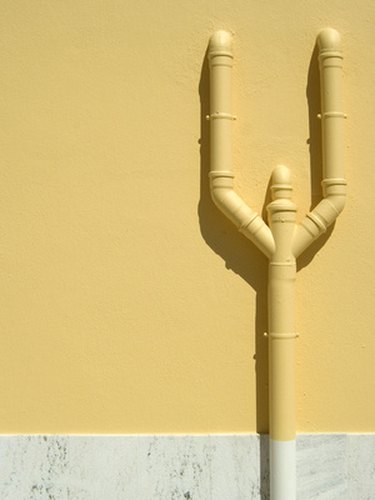Things You'll Need
Reciprocal saw
Reciprocal saw blades
ABS drain pipe (black pipe suitable for drain applications)
ABS drain fittings (including sanitary tee)
ABS glue
Flexible couplings
Plumber’s tape
Drill
Screws
Pencil
Tape measure
Screwdriver

A kitchen or bath renovation project often requires completing rough plumbing before installing tiles, fixtures or wall coverings. To install a new drain into existing lines, you'll cut the old, amend the gap and run a new pipe to the desired location. Toying with drain lines might sound tough, but with patience and attention to detail, a beginning plumber can manage the job without too much difficulty.
Step 1
Choose a location for the new drain to join the existing lines that saves materials and effort. Use a pencil to mark the location of the cut on the existing line. The mark indicates the place where the new line will branch from the old and where you will install a fitting, such as a sanitary tee. Choose a fitting that connects to the existing line with flexible couplings, not glue.
Video of the Day
Step 2
Use a tape measure to measure the width of your fitting and transfer the measurement to the existing sewer lines at the mark from Step 1.
Step 3
Cut the existing sewer line using a reciprocal saw. If the pipe wobbles or moves too much while cutting, have a partner hold it in place, or secure it to framing members, such as studs, using plumber's tape. To use plumber's tape, wrap the tape around the pipe, align holes and screw through the tape's holes to a framing member.
Step 4
Remove the cut portion of pipe. Place a flexible coupling between the gap created by the cut, slip it onto one of the exposed pipes and slide until fully inserted. Repeat for the pipe on the opposite side of the gap. Place the tee fitting in the gap and slide each flexible coupling back toward the gap until it covers and joins the existing pipe with the new fitting. Repeat for the opposite side.
Step 5
Use a screwdriver to tighten the clamps that secure the couplings in place. Turn clockwise to tighten. Repeat for each clamp. Use plumber's tape to support the couplings beneath the point at which old and new pipe meet.
Step 6
Add portions of pipe and additional fitting to the newly created branch. If using ABS glue, clean the inside of fittings and the outside of pipe, apply a thorough coat of glue to each, join them, twist and hold for thirty seconds. Allow glued joints to cure 10 minutes.
Tip
A cable-type pipe cutter requires more elbow grease than a reciprocal saw, but can cut pipes in tight spots.
Warning
Always wear goggles and gloves when using a reciprocal saw.
Video of the Day